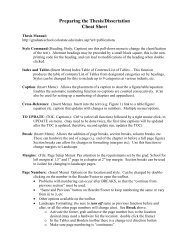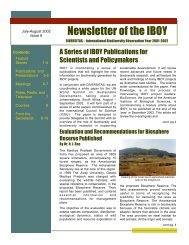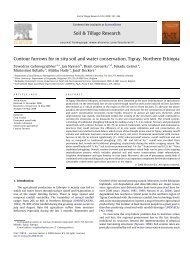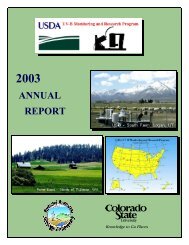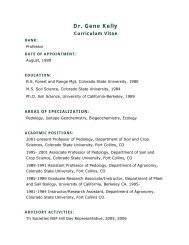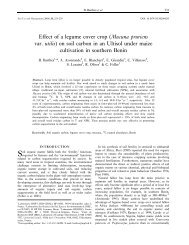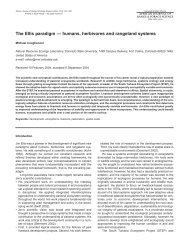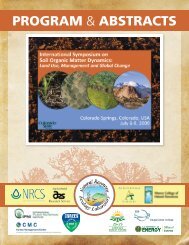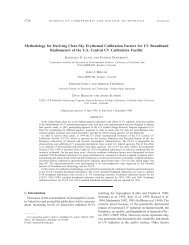Utilization Assessment of Prosopis juliflora in Afar Region, Ethiopia ...
Utilization Assessment of Prosopis juliflora in Afar Region, Ethiopia ...
Utilization Assessment of Prosopis juliflora in Afar Region, Ethiopia ...
- No tags were found...
You also want an ePaper? Increase the reach of your titles
YUMPU automatically turns print PDFs into web optimized ePapers that Google loves.
<strong>Utilization</strong> <strong>Assessment</strong> <strong>of</strong> <strong>Prosopis</strong> <strong>juliflora</strong> <strong>in</strong> <strong>Afar</strong> <strong>Region</strong>, <strong>Ethiopia</strong>US Forest Service, USDA Office <strong>of</strong> International ProgramsUSAID Pastoral Livelihoods Initiative II Project (PLI II)Tewodros Wakie 1 , Paul Evangelista 2 and Mel<strong>in</strong>da Laituri 31 Graduate Degree Program <strong>in</strong> Ecology,Colorado State University2 Natural Resource Ecology Laboratory,Colorado State University3 Department <strong>of</strong> Ecosystem Science and Susta<strong>in</strong>ability,Colorado State UniversityJuly 20121
Introduction<strong>Prosopis</strong> species is one <strong>of</strong> the highly <strong>in</strong>vasive plants <strong>in</strong> the world. Among the 45recognized <strong>Prosopis</strong> species (Felker, 2005), <strong>Prosopis</strong> glandulosa, P. velut<strong>in</strong>a, P. <strong>juliflora</strong> and P.pallida are reported to be generally problematic (Pasiecznik, 2001). <strong>Prosopis</strong> has <strong>in</strong>vadedmillions <strong>of</strong> hectares <strong>of</strong> land <strong>in</strong> the arid and semi-arid cont<strong>in</strong>ents <strong>of</strong> Asia, Africa, Australia andAmericas. In Africa alone, <strong>Prosopis</strong> is believed to have <strong>in</strong>vaded over 4 million hectares,threaten<strong>in</strong>g crop and rangeland production, desiccat<strong>in</strong>g water resources and displac<strong>in</strong>g nativeflora and fauna (Witt, 2010; Zimmerman et al., 2006). However, quantitative assessments <strong>of</strong> thearea covered by <strong>Prosopis</strong> and its rate <strong>of</strong> spread have not been undertaken <strong>in</strong> <strong>Ethiopia</strong>(Mauremootoo, 2006). In East Africa, P. Juliflora was <strong>in</strong>troduced <strong>in</strong> the 1970s throughcollaborative projects <strong>in</strong>volv<strong>in</strong>g local governments and outside agencies (Coppock et al., 2005).This is very likely to be the case for Kenya and <strong>Ethiopia</strong>, but other reports suggests that<strong>in</strong>troduction to the Sudan took place as early as 1917 (Broun and Massey, 1929. Although P.Juliflora, P. Pallida and P. Chill<strong>in</strong>es are present <strong>in</strong> neighbor<strong>in</strong>g Sudan and Kenya (Choge et al.,2007; Sallah and Yagi, 2011), only P. <strong>juliflora</strong> has been reported <strong>in</strong> <strong>Ethiopia</strong>. In the <strong>Afar</strong> region<strong>of</strong> <strong>Ethiopia</strong>, where P. <strong>juliflora</strong> is hav<strong>in</strong>g dramatic impacts across the landscape, its spread andimpacts on resources has been ranked as one <strong>of</strong> the lead<strong>in</strong>g threats to traditional land use,exceeded only by drought and conflict (EPP, 2006). Nationally, P. <strong>juliflora</strong> has been ranked asthe most problematic plant <strong>in</strong>vader <strong>in</strong> <strong>Ethiopia</strong> (Tessema, 2007).Interviews <strong>of</strong> community members <strong>in</strong> the <strong>Afar</strong> <strong>Region</strong> <strong>of</strong> <strong>Ethiopia</strong> <strong>in</strong>dicate that<strong>in</strong>tentional plant<strong>in</strong>g <strong>of</strong> P. <strong>juliflora</strong> was facilitated by several government organizations, <strong>in</strong>clud<strong>in</strong>gthe M<strong>in</strong>istry <strong>of</strong> Agriculture, Federal Relief and Rehabilitation Commission, and ZemechaMemria – a national program <strong>of</strong> Derg adm<strong>in</strong>istration. Abas Mohamed Shami, a key <strong>in</strong>formant <strong>in</strong>this study and a local <strong>Afar</strong> who organized the first P. <strong>juliflora</strong> plant<strong>in</strong>g activities <strong>in</strong> Gewane area,mentions that afforestation was part <strong>of</strong> the Derg‟s “Green Campaign” policy <strong>in</strong> the aftermath <strong>of</strong><strong>Ethiopia</strong>‟s 1970 drought. Gewane Woreda was then under the Assebeteferi Awraja, HarergeKiflehager. (Woreda, Awraja and Kiflehager are adm<strong>in</strong>istrative units equivalent to counties,zones and regions, respectively). In1979, thousands <strong>of</strong> P. <strong>juliflora</strong>seedl<strong>in</strong>gs were brought from anursery <strong>in</strong> Hirna, Harerge, and wereplanted <strong>in</strong> all Assebeteferi Awraja<strong>in</strong>clud<strong>in</strong>g Amibera, Gewane, Afdemand East Awash (now known asAwash). However, the speciesbecame <strong>in</strong>vasive <strong>in</strong> the early 1990s,<strong>in</strong> co<strong>in</strong>cidence with the newTransitional Government <strong>in</strong> <strong>Ethiopia</strong>that is also referred to by politicalopposition groups as Woyane. It tookonly 20 years for the species tonaturalize, produce a selfperpetuat<strong>in</strong>gcommunity and becomean <strong>in</strong>dependent <strong>in</strong>vader. In <strong>Afar</strong>region, the tree is now known as<strong>Prosopis</strong> <strong>juliflora</strong> <strong>in</strong>festation <strong>in</strong> northern <strong>Ethiopia</strong>.2
Dergi Hara, Woyane Hara or just Woyane. Experiences from other countries <strong>in</strong>dicate that thetree is highly <strong>in</strong>vasive and difficult to eradicate. Expensive and unsuccessful eradication effortsaround the world have led the <strong>Ethiopia</strong>n Government, and some NGO‟s, to follow a strategy <strong>of</strong>controll<strong>in</strong>g P. <strong>juliflora</strong> through utilization.ObjectivesThe objectives <strong>of</strong> our study were to:Methods1) Investigate the diverse uses <strong>of</strong> P. <strong>juliflora</strong> globally to determ<strong>in</strong>e if and how the speciesmay augment the livelihoods <strong>of</strong> <strong>Afar</strong> people <strong>in</strong> <strong>Ethiopia</strong>;2) Assess exist<strong>in</strong>g P. <strong>juliflora</strong> control and utilization strategies and evaluate theirpr<strong>of</strong>itability and application for <strong>Ethiopia</strong>ns;3) Develop prelim<strong>in</strong>ary maps <strong>of</strong> the potential habitat and distribution <strong>of</strong> P. <strong>juliflora</strong> forthe <strong>Afar</strong> <strong>Region</strong> and <strong>Ethiopia</strong>.Study SiteThe study was conducted <strong>in</strong> North Eastern part <strong>of</strong> <strong>Ethiopia</strong>, approximately locatedbetween 8 0 51‟ and 14 0 34' latitudes and, 39 0 47‟ and 42 0 24' longitudes. <strong>Afar</strong> can refer to theplace as well as the people liv<strong>in</strong>g <strong>in</strong> the area. The population is largely rural and pastoralist. <strong>Afar</strong>,which is further divided <strong>in</strong>to five smaller adm<strong>in</strong>istrative zones is one <strong>of</strong> the n<strong>in</strong>e adm<strong>in</strong>istrativeregions <strong>in</strong> <strong>Ethiopia</strong>. It has an arid and semi-arid climate with most <strong>of</strong> its Northern part be<strong>in</strong>g saltyand or below sea level. The study however focuses on the Southern and central part <strong>of</strong> <strong>Afar</strong>where P. <strong>juliflora</strong> <strong>in</strong>vasion is widespread. Elevation ranges from -144 m B.S.L to 2,870 m A.S.L.Ra<strong>in</strong>fall <strong>in</strong> the central <strong>Afar</strong> area ranges from 330 mm to 820 mm. Although extremetemperatures were recorded <strong>in</strong> the Northern part <strong>of</strong> <strong>Afar</strong>, <strong>in</strong> the central area 35 years <strong>of</strong>metrological records show that the average lowest temperature is 9 0 C and average highesttemperature is 40 0 C (Kebede, 2009).Literature ReviewA search and review <strong>of</strong> scholarly articles were conducted us<strong>in</strong>g resources from theColorado State University library, <strong>in</strong>clud<strong>in</strong>g the Web <strong>of</strong> Science® onl<strong>in</strong>e academic citation<strong>in</strong>dex (http://apps.web<strong>of</strong>knowledge.com/) and Google Scholar © Search eng<strong>in</strong>e. Additionalstudies and reports compiled by government organizations and non-government organizations(NGO) on P. <strong>juliflora</strong> were collected from various government and non-government sources <strong>in</strong><strong>Ethiopia</strong>, and properly <strong>in</strong>vestigated. In addition, student theses and dissertations completedwith<strong>in</strong> and outside <strong>of</strong> <strong>Ethiopia</strong> were reviewed.Economic AnalysesLocal knowledge was used to identify zones and woredas that have been affected by P.<strong>juliflora</strong> <strong>in</strong>vasion <strong>in</strong> <strong>Afar</strong> <strong>Region</strong>. Kebele‟s (the lowest adm<strong>in</strong>istrative areas) and householdswere then randomly chosen from the selected zones and woredas. Field visits were made toselected kebeles and households where group discussions were conducted with pastoralists, agropastoralists, and farmers. Strengths, Weaknesses, Opportunities, and Threats (SWOT) analysis3
(Ommani, 2011) was used to evaluate the effectiveness <strong>of</strong> exist<strong>in</strong>g P. <strong>juliflora</strong> utilizationstrategies. Rapid market assessments were conducted for important P. <strong>juliflora</strong> products andcompared with cotton, a potential P. <strong>juliflora</strong> replacement crop <strong>in</strong> <strong>Afar</strong> valleys. Cash flow<strong>in</strong>formation was collected and pr<strong>of</strong>itability <strong>of</strong> convert<strong>in</strong>g P. <strong>juliflora</strong> <strong>in</strong>vaded lands <strong>in</strong>to irrigatedcotton farms were assessed us<strong>in</strong>g Net Present Value (NPV; Connor, 2006) and Internal Rate <strong>of</strong>Return (IRR; Johnstone, 2008) models. High discount rate, 21 % was used on purpose to adjustfor low or non-existent land rent, tax rates, and other risk factors. IRR, the discount rate thatmakes NPV 0, was calculated us<strong>in</strong>g the trial and error method. For a given time <strong>of</strong> cash flow - t,discount rate <strong>of</strong> –i, and a net cash flow (<strong>in</strong>flows less outflows) <strong>of</strong>-R, the Net Present Value isgiven by:Positive NPV results and higher IRR values <strong>in</strong>dicate pr<strong>of</strong>itability.Spatial AnalysesWe conducted two spatial analyses to model the distribution <strong>of</strong> P. <strong>juliflora</strong> at the countryleveland for the <strong>Afar</strong> <strong>Region</strong>. Our first species distribution model was a simple environmentalenvelope model cover<strong>in</strong>g the extent <strong>of</strong> <strong>Ethiopia</strong>. From our literature search, we found that P.<strong>juliflora</strong> has def<strong>in</strong>ed climate parameters. The species is known to occur <strong>in</strong> areas whereprecipitation ranges between 100 mm and 1000 mm; elevation from 0 to 1500 m, and meanannual temperature is greater than 20 0 C (Pasiecznik, 2001). Climate data for <strong>Ethiopia</strong> wasobta<strong>in</strong>ed from WorldClim (http://www.worldclim.org/bioclim) represent<strong>in</strong>g precipitation andtemperatures <strong>in</strong> digital raster formats, and elevation determ<strong>in</strong>ed from a Digital Elevation Model(DEM). The raster calculator function was then used <strong>in</strong> ArcGIS (Version: 10.0; ESRI, 2011) toidentify the suitable ranges <strong>of</strong> the species.At the regional level, a more detailed species distribution model<strong>in</strong>g approach wasfollowed us<strong>in</strong>g six environmental predictors and the Maxent (Version: 3.3.3K; Philips et al,2006) species habitat model<strong>in</strong>g s<strong>of</strong>tware. The predictor variables <strong>in</strong>cluded the distance fromwater, distance from roads and soil layers acquired from the Woody Biomass Project (Sutcliffe,2006), and elevation, slope and aspect derived from our DEM at 30 m resolution. Predictors wereassessed for multicol<strong>in</strong>iarity us<strong>in</strong>g VisTrails, SAHM package (Callahan et al., 2006). A total <strong>of</strong>168 presence po<strong>in</strong>ts for P. <strong>juliflora</strong>, collected from the field <strong>in</strong> spr<strong>in</strong>g 2012, were used to tra<strong>in</strong> theMaxent model. A total <strong>of</strong> 5,000 iterations were run with 25 random presence po<strong>in</strong>ts withheld totest the model.Results<strong>Prosopis</strong> as Animal Feed<strong>Prosopis</strong> species are widely known for their use as animal feed. Fruits <strong>of</strong> <strong>Prosopis</strong> aresweet, nutritious, have low concentrations <strong>of</strong> tann<strong>in</strong>s and other unpalatable chemicals(Pasiecznik, 2001). However, the leaves are unpalatable and the seeds, which are high <strong>in</strong> prote<strong>in</strong>,are not easily digestible by animals, requir<strong>in</strong>g some form <strong>of</strong> gr<strong>in</strong>d<strong>in</strong>g and process<strong>in</strong>g by humans.In India, chemical composition and nutritive value <strong>of</strong> P. <strong>juliflora</strong> has been well reviewed and4
compiled. As a dry fodder, pods <strong>of</strong> P. <strong>juliflora</strong> conta<strong>in</strong>, 15% crude sugar, 12% crude prote<strong>in</strong>, amoderate level <strong>of</strong> digestible crude prote<strong>in</strong> with high level <strong>of</strong> energy; seeds conta<strong>in</strong> 31-37%prote<strong>in</strong> (Sawal et al., 2004).In several parts <strong>of</strong> <strong>Afar</strong>, <strong>Ethiopia</strong>, P. Juliflora has become a major source <strong>of</strong> dry seasonfeed for goats, camels and donkeys. Cattle and sheep also feed on the pod but a local diseasecalled „Armeku‟, that affects the nervous system <strong>of</strong> these animals has been reported by <strong>Afar</strong>pastoralists. The symptoms described by pastoralists <strong>in</strong> this study are consistent with aneurological disease described by scientists <strong>in</strong> Brazil. Accord<strong>in</strong>g to this Brazilian study, thecranial nerve function <strong>of</strong> cattle and goats that fed a ration conta<strong>in</strong><strong>in</strong>g 50 % and 75% <strong>of</strong> dryground pods, were impaired and denervation atrophy has occurred <strong>in</strong> masseter and masticatorymuscles (Tabosa et al., 2006). With the right proportion, however, P. <strong>juliflora</strong> pods can beeffectively used <strong>in</strong> animal feed <strong>in</strong>dustry. Mahgoub et al. (2003), found that 20% proportion or200 g/kg, P. <strong>juliflora</strong> pods can improve feed <strong>in</strong>take, feed conversion, and body weight ga<strong>in</strong> <strong>of</strong>Omani goats without compromis<strong>in</strong>g product quality. In <strong>Ethiopia</strong>, 10 and 20% <strong>in</strong>clusion <strong>of</strong>ground P. <strong>juliflora</strong> pods was found to reduce feed production costs without compromis<strong>in</strong>gbiological performance. At 30%, however, the positive results <strong>of</strong> P. <strong>juliflora</strong> dim<strong>in</strong>ished with thegrowth and feed <strong>in</strong>take <strong>of</strong> poultry (Girma et al., 2011).The average amount <strong>of</strong> pod produced by one tree <strong>in</strong> a s<strong>in</strong>gle year ranges from 20 Kg to50 Kg (Pasiecznik, 2001). Farm Africa, an NGO work<strong>in</strong>g <strong>in</strong> <strong>Afar</strong> region <strong>of</strong> <strong>Ethiopia</strong> has<strong>in</strong>troduced P. <strong>juliflora</strong> pod gr<strong>in</strong>d<strong>in</strong>g mach<strong>in</strong>es, and has formed cooperatives that carry out podharvest<strong>in</strong>g, collection, gr<strong>in</strong>d<strong>in</strong>g and sell<strong>in</strong>g activities. In addition to generat<strong>in</strong>g <strong>in</strong>come tocooperative members, this strategy will reduce propagule pressure and play a positive role <strong>in</strong>carbon sequestration. However, to become a good pr<strong>of</strong>itable bus<strong>in</strong>ess activity, the strategy needsreliable market and good ra<strong>in</strong>fall. With good ra<strong>in</strong>fall and successful poll<strong>in</strong>ation, P. <strong>juliflora</strong> seedscan flower, fruit and produce pods twice <strong>in</strong> a s<strong>in</strong>gle year. The primary constra<strong>in</strong>ts to a bus<strong>in</strong>essare the seasonal variability <strong>of</strong> the region and lack <strong>of</strong> dependable market/markets for large scaleproduction. Currently, cooperatives prepare P. <strong>juliflora</strong> flour after receiv<strong>in</strong>g orders from buyers.The opportunities <strong>in</strong>clude presence <strong>of</strong> P. <strong>juliflora</strong> stands near water sources that can producepods <strong>in</strong>dependent <strong>of</strong> ra<strong>in</strong>fall availability, and presence <strong>of</strong> small local markets. Several feedprocess<strong>in</strong>g plants exist <strong>in</strong> the country and the people who run these plants seem to be unaware <strong>of</strong>the value <strong>of</strong> P. <strong>juliflora</strong> as a feed constitute. Feed processors as well as dairy and fatten<strong>in</strong>g farmslocated <strong>in</strong> <strong>Afar</strong> region and its vic<strong>in</strong>ities should be targeted and should be communicated aboutthe high nutritive value <strong>of</strong> P. <strong>juliflora</strong> pods and its role <strong>in</strong> reduc<strong>in</strong>g animal feed cost.Use <strong>of</strong> <strong>Prosopis</strong> for Energy ProductionEnergy from <strong>Prosopis</strong> can be obta<strong>in</strong>ed through several ways that <strong>in</strong>clude, direct burn<strong>in</strong>g,carbonization, gasification, pulverization, and fermentation (Pasiecznik, 2001; Silva et al., 2011).<strong>Prosopis</strong> trees are good sources <strong>of</strong> fuel wood around the world; <strong>in</strong> <strong>Ethiopia</strong>, the trees are made<strong>in</strong>to charcoal which are then transported and sold <strong>in</strong> urban areas. Over 90% <strong>of</strong> energyconsumption <strong>in</strong> <strong>Ethiopia</strong> comes from biomass fuel (Mekonnen, 2009). Currently, most <strong>of</strong> the fuelwood biomass <strong>in</strong> <strong>Afar</strong> region comes from Acacia and <strong>Prosopis</strong> trees.5
Accord<strong>in</strong>g to a FAOestimate, <strong>in</strong> 2010, <strong>Ethiopia</strong>produced 3.7 million tones<strong>of</strong> charcoal and exported 84tons to other countries(FAOSTAT, 2011). Itshould be noted, however,that unsusta<strong>in</strong>ableharvest<strong>in</strong>g can lead todeforestation. In <strong>Ethiopia</strong>,cutt<strong>in</strong>g <strong>in</strong>digenous trees forfuel wood purposes hasresulted <strong>in</strong> loss <strong>of</strong> naturalforests and land degradation(Haile et al., 2010;Mekonnen, 2009). In the<strong>Afar</strong> <strong>Region</strong>, <strong>in</strong>digenoustrees are still harvested forenergy purposes, but theavailability <strong>of</strong> P. <strong>juliflora</strong>has relatively reduced theharvest<strong>in</strong>g pressure on localtrees.Women remov<strong>in</strong>g uprooted P. <strong>juliflora</strong> stumps from<strong>in</strong>vaded lands <strong>in</strong> the <strong>Afar</strong> <strong>Region</strong>, <strong>Ethiopia</strong>.The high demand and consumption <strong>of</strong> charcoal <strong>in</strong> the country, and suitability <strong>of</strong> P.<strong>juliflora</strong> for charcoal production have resulted <strong>in</strong> some form <strong>of</strong> control through utilization.Charcoal <strong>in</strong> the <strong>Afar</strong> region is produced traditionally with very m<strong>in</strong>imal cost. Earth mounds arebuilt at harvest<strong>in</strong>g sites; hence, there is no or little transportation cost <strong>of</strong> raw woody material.This traditional method doesn‟t require large <strong>in</strong>vestments and the labor associated with charcoalproduction is cheaply available <strong>in</strong> the area. Moreover, production size is not a limit. There is wellestablished market channel that beg<strong>in</strong>s at the production site and ends at the consumers door step(Kwaschik, 2008; EPP, 2006). However, policies regard<strong>in</strong>g charcoal production vary and arefrequently modified. At the time <strong>of</strong> this report, several loopholes exist <strong>in</strong> the various regionallaws and regulations. As a result, the legality <strong>of</strong> charcoal production is poorly def<strong>in</strong>ed anddifficult to regulate. For example, <strong>in</strong>digenous trees such as Acacia nilotica, Tamarix aphila, andCombretum aculeatum are harvested for charcoal production legally from leased woodlands andillegally from communal lands.Controll<strong>in</strong>g P. <strong>juliflora</strong> <strong>in</strong>vasion through charcoal production requires the removal <strong>of</strong> itsstumps. This is <strong>of</strong>ten not case, however, because stump removal <strong>in</strong>curs additional time and laborcosts. Additionally, the removal <strong>of</strong> stumps decreases the resource base, thereby affect<strong>in</strong>g thesusta<strong>in</strong>ability <strong>of</strong> this scheme. It would seem that for charcoal production to be an effectivecontrol mechanism, it needs to be legalized and should be implemented accord<strong>in</strong>g to the regionsP. <strong>juliflora</strong> control guidel<strong>in</strong>es. Experience from bamboo management, <strong>in</strong>creased valuation, andmarket<strong>in</strong>g by INBAR (International Network for Bamboo and Rattan), and other privatecompanies <strong>in</strong> Addis Ababa should be exam<strong>in</strong>ed as a model <strong>in</strong> P. <strong>juliflora</strong> products process<strong>in</strong>gand market<strong>in</strong>g.6
<strong>Prosopis</strong> Wood ProductsStudies <strong>in</strong>dicate that good quality lumber can be produced form <strong>Prosopis</strong> wood. <strong>Prosopis</strong>lumber compares favorably <strong>in</strong> color, hardness and shr<strong>in</strong>kage values to the world‟s f<strong>in</strong>est timbers(Felker, 1999; Gomes, 2007). All data for physical and mechanical properties <strong>of</strong> P. <strong>juliflora</strong>wood fall well with<strong>in</strong> acceptable limits for mak<strong>in</strong>g wood products (Pasiecznik, 2001). The woodis resistant to termites, and white and brown rot fungi; is dimensionally stable and its mechanicalproperties compared well with P<strong>in</strong>us patula, a wood widely used <strong>in</strong> Kenya for constructionpurposes (Sirmah et al., 2008). However, trees are <strong>of</strong>ten crooked, thorny and have shortharvestable trunk. As a result, short length wood products are produced form P. <strong>juliflora</strong> trees.The wood products can be used for f<strong>in</strong>e furniture and floor<strong>in</strong>g (Felker, 1999), railway slippers(Sirmah et al., 2008), and tool handles (Shukla et al., 1990). A s<strong>in</strong>gle layer particleboard that wasproduced from P. <strong>juliflora</strong> with 11% res<strong>in</strong> content and a five-m<strong>in</strong>ute press cycle was found to beadequate for general uses (Ashori and Nourbakhsh, 2008). Mix<strong>in</strong>g P. glandulosa chips withother tees <strong>in</strong> USA has also resulted <strong>in</strong> acceptable chip wood product (Hiziroglu, 2010).In the <strong>Afar</strong> <strong>Region</strong>, P. <strong>juliflora</strong> trees are harvested for a less quality product, (e.g.,charcoal) before they reach maturity. The current study found the presence <strong>of</strong> only a few maturestands that could be used for lumber production. Currently, P. <strong>juliflora</strong>, or even the larger sizedAcacia nilotica trees, are not harvested for timber or lumber products. Nevertheless, studiesmade <strong>in</strong> <strong>Ethiopia</strong> and other countries suggest that management <strong>of</strong> P. <strong>juliflora</strong> for commercialtimber could a pr<strong>of</strong>itable and successful bus<strong>in</strong>ess venture (Zewdie and Worku, 2009; Felker andGuevara, 2003).The drawback <strong>of</strong> this bus<strong>in</strong>ess plan comes from keep<strong>in</strong>g the trees for long periods <strong>of</strong>time. Trees kept for several years will become seed sources, <strong>in</strong>crease the propagule pressure, andwill facilitate new <strong>in</strong>vasions. The plan may also violate local policies and guidel<strong>in</strong>es s<strong>in</strong>ce thecontrol guidel<strong>in</strong>es for P. <strong>juliflora</strong> <strong>in</strong> the <strong>Afar</strong> <strong>Region</strong> recommends harvest<strong>in</strong>g before seed sett<strong>in</strong>g(Anonymous, 2002). Comb<strong>in</strong><strong>in</strong>g pod harvest<strong>in</strong>g with timber production may help resolve theseissues.Use <strong>of</strong> <strong>Prosopis</strong> for Other Products<strong>Prosopis</strong> species are good sources <strong>of</strong> nectar and honey production. The species are alsoknown for its food and gum products that can be produced from its pods and barks.Unfortunately, these qualities were not considered when P. <strong>juliflora</strong> was first <strong>in</strong>troduced to<strong>Ethiopia</strong>. Compared to other <strong>Prosopis</strong> species, P. <strong>juliflora</strong> pods are bitter and <strong>in</strong>edible (Felker,2005). In Kenya bread made with 20% P. <strong>juliflora</strong> pods have a good taste and nutritional value;but the presence <strong>of</strong> aflatox<strong>in</strong>s and ochratox<strong>in</strong> A has warrant additional <strong>in</strong>vestigations before anyrecommendations are given (Choge et al., 2007). In Brazil, highly nutritious honey-like syrupsAt the Adal Bamboo Floor<strong>in</strong>g and Charcoal Factory, <strong>in</strong> Addis Ababa, several products areproduced from bamboo stems. Round and split bamboos are used for house construction whilelam<strong>in</strong>ated bamboo boards, veneers and panels are used to make furniture, floor<strong>in</strong>g, ro<strong>of</strong><strong>in</strong>g,curta<strong>in</strong>s, as well as door and w<strong>in</strong>dow frames. The rema<strong>in</strong><strong>in</strong>g short length splits are used toproduce table mats, <strong>in</strong>cense sticks, tooth picks, match sticks and tip holders. Bamboo sawdustand leftovers are then carbonized <strong>in</strong>to charcoal through efficient retort kilns that have highcarbonization efficiency and emit little amount <strong>of</strong> pollutants. The charcoal is converted <strong>in</strong>tobriquettes, properly packed and sold at national and <strong>in</strong>ternational markets.7
were produced form P. <strong>juliflora</strong> pods that can be comb<strong>in</strong>ed with other <strong>in</strong>gredients to producecakes, cookies and other bakery products (Guilherme et al., 2007).Extractives <strong>of</strong> P. <strong>juliflora</strong> have a potential to be used as natural antioxidants <strong>in</strong> the food,cosmetic or pharmaceutical <strong>in</strong>dustries (Sirmah et al., 2011). A study made <strong>in</strong> India <strong>in</strong>dicated thatactivated carbon, which has applications <strong>in</strong> environmental clean<strong>in</strong>g, can be produced form P.<strong>juliflora</strong> trees (Kailappan et al., 2000). These and other food or <strong>in</strong>dustrial uses <strong>of</strong> the tree haveyet to be explored <strong>in</strong> <strong>Ethiopia</strong>.Conversion <strong>of</strong> P. Juliflora Invaded Lands <strong>in</strong>to Commercial FarmsThe last proposed strategy to control P. <strong>juliflora</strong> <strong>in</strong>vestigated <strong>in</strong> the current study is theconversion <strong>of</strong> <strong>in</strong>vaded lands to irrigated farms with a one-time production <strong>of</strong> charcoal as a byproduct.Conversion ensures removal <strong>of</strong> P. <strong>juliflora</strong> and reduces the likelihood <strong>of</strong> re-<strong>in</strong>festation.In Awash, Sheleko and Melkasedi areas <strong>of</strong> <strong>Afar</strong>, where irrigated farm<strong>in</strong>g is commonly practiced,agro-pastoralists have suggested that P. <strong>juliflora</strong> may be controlled soon. Onions, tomatoes andother vegetables are be<strong>in</strong>g grown <strong>in</strong> reclaimed lands. Perhaps the best option, however, is theconversion <strong>of</strong> <strong>in</strong>vaded lands <strong>in</strong>to cotton farms. Cotton can be grown <strong>in</strong> all three Awashwatersheds (Upper Awash, Middle Awash and Lower Awash), and there is a long tradition <strong>of</strong>cotton farm<strong>in</strong>g already present <strong>in</strong> the region. Technical support is available from the nearbyWorer Institute <strong>of</strong> Agricultural Research, and knowledge can be transferred from <strong>in</strong>vestorswork<strong>in</strong>g <strong>in</strong> the area to small scale farmers or cooperatives. Cotton farm<strong>in</strong>g can be started withlittle <strong>in</strong>itial <strong>in</strong>vestments. Mach<strong>in</strong>eries and equipment are readily available for rentals, and cottonhas a relatively longer shelf life and is not considered a perishable crop. Moreover, settledfarm<strong>in</strong>g <strong>in</strong> <strong>Afar</strong> region is encouraged by federal and regional policies (MoFED, 2010).The demand for cotton is high <strong>in</strong> both domestic and <strong>in</strong>ternational markets. India, Pakistanand Thailand are already major cotton exports for <strong>Ethiopia</strong>. The economic benefits <strong>of</strong> cottonfarm<strong>in</strong>g are numerous and would benefit multiple levels <strong>of</strong> <strong>Ethiopia</strong>n society, <strong>in</strong>clud<strong>in</strong>g smallhold<strong>in</strong>g farms, private commercial farms, state farms, local assemblers, g<strong>in</strong>ners, handlooms andhand crafts, sp<strong>in</strong>n<strong>in</strong>g and yarn<strong>in</strong>g plants, textile mills, garment and apparel factories, oil mills,dairy and fatten<strong>in</strong>g farms, wholesalers, retailers, and consumers. There are risks, however, anddrought, ris<strong>in</strong>g fuel costs, <strong>Ethiopia</strong>‟s high rate <strong>of</strong> <strong>in</strong>flation, (CIA fact book, 2011), loss <strong>of</strong> landproductivity, and access to credit (Bosena et al., 2011) could be problematic.Field experiments conducted near Alage and Ziway, with a seed obta<strong>in</strong>ed from Metehara(near Afrar region), suggested that P. <strong>juliflora</strong> has an average annual yield <strong>of</strong> 13 m 3 /ha on freshweight bases (Abebe, 1994). At 10% moisture content and 810 kg/m 3 average density given forthe species (Pasiecznik, 2001), the above-ground wood biomass that can be obta<strong>in</strong>ed <strong>in</strong> a year is10,530 kg or10.5 tons/ha. Therefore, from a five year old P. <strong>juliflora</strong> stand, one can get 52,650kg or 52 tons <strong>of</strong> wood biomass that can be used for charcoal mak<strong>in</strong>g. At 1:4 average biomass tocharcoal conversion rate (Pasiecznik, 2001; Kwaschik, 2008) this will result <strong>in</strong> 438 bags <strong>of</strong>charcoal per ha, each weigh<strong>in</strong>g 30 kg. A bag <strong>of</strong> charcoal is sold for 65 Birr <strong>in</strong> <strong>Afar</strong>, and for 75Birr at Addis Ababa market. After deduct<strong>in</strong>g 8,500 Birr for wood harvest<strong>in</strong>g, stump excavation,packag<strong>in</strong>g and other labor costs, at <strong>Afar</strong>, a net pr<strong>of</strong>it <strong>of</strong> 20,000 Birr/ha can be obta<strong>in</strong>ed fromcharcoal production. With this amount <strong>of</strong> money, one can buy a good water pump for acooperative or an <strong>in</strong>dividual farmer who will be <strong>in</strong>volved <strong>in</strong> this conversion plan.8
Table 1. Costs associated with P. <strong>juliflora</strong> removal and conversion to irrigated cotton farm. Datacollected us<strong>in</strong>g rapid market assessment tools <strong>in</strong> March 2012.ActivityCost/ha <strong>in</strong> Birr Sale <strong>in</strong> Birr Pr<strong>of</strong>it beforeTaxYear 1 Year 2 Year 1 Year 2 Year 1 Year 2<strong>Prosopis</strong> harvest<strong>in</strong>g, stump removal - 3,000 20,000 -and charcoal mak<strong>in</strong>g and sell<strong>in</strong>gWater Pump <strong>in</strong>clud<strong>in</strong>g Ma<strong>in</strong>tenance 20,000 2,000 - -Plow<strong>in</strong>g and seed bed preparation 2,500 2,500(Rental)Water Canal construction,2,400 2,400ma<strong>in</strong>tenance, and ridg<strong>in</strong>gImproved seed 400 400Labor cost for water<strong>in</strong>g and 4,100 4,100guard<strong>in</strong>gWeed<strong>in</strong>g and Th<strong>in</strong>n<strong>in</strong>g 1,100 1,600Chemical costs 1,800 2,000Gas, oil and labor cost for chemical 700 700applicationMotorized Chemical Sprayer 2000 400<strong>in</strong>clud<strong>in</strong>g ma<strong>in</strong>tenanceHarvest<strong>in</strong>g costs 2,500 2,500Packag<strong>in</strong>g for 32 Qu<strong>in</strong>tal 2,500 2,500Transportation cost, 60 Birr per 1,800 1,800Qu<strong>in</strong>talDepreciation cost for Sprayer and 1,500 1,500Water pump ( with goodma<strong>in</strong>tenance and straight l<strong>in</strong>emethod)32 Qu<strong>in</strong>tal <strong>of</strong> Raw Cotton at 1,200 - - 38,400 40,000Birr for year one and 1,250 Birr foryear 2, at Awash MarketTotal 43,300 27,500 58,400 40,000 15,100 12,500Us<strong>in</strong>g cash flow data showed <strong>in</strong> Table 1 and 0.21 discount<strong>in</strong>g rate, NPV calculated forthe first year has a positive value. (0.826 * 58,400) – 43,300 = 4,938. Similarly, NPV calculatedfor the second year is positive. (0.697 * 40,000) – 27, 500 = 380. Total NPV = 5, 318. TheInternal Rate <strong>of</strong> Return, IRR, calculated us<strong>in</strong>g the cash flow statement shown <strong>in</strong> Table 1,approximately equals 27 %. (58,400) / (1 + r) 1 + (40, 000) / (1+ r) 2 - 43,300 - 27,500 ≈ 27 %Both NPV and IRR models <strong>in</strong>dicate that convert<strong>in</strong>g P. <strong>juliflora</strong> lands <strong>in</strong>to irrigated cottonfarms would likely be pr<strong>of</strong>itable. Studies that compare productivity <strong>of</strong> traditionally managed9
pasture lands with irrigated farms have not been conducted for the Awash Valley; however,privately and cooperatively owned farms generally are more pr<strong>of</strong>itable when compared to stateowned farms (Behnke and Kerven, 2011). When try<strong>in</strong>g to control the negative impactsassociated with <strong>in</strong>vasive species, the benefits from land conversion and/or other strategies to<strong>in</strong>crease value from the land outweighs the costs <strong>of</strong> do<strong>in</strong>g noth<strong>in</strong>g. The advantages <strong>of</strong> large-scalecommercial farm<strong>in</strong>g <strong>in</strong> Awash may be debatable, but the results <strong>of</strong> this study suggests thatconvert<strong>in</strong>g P. <strong>juliflora</strong> <strong>in</strong>vaded lands <strong>in</strong>to small-scale cooperative owned cotton farms is a costeffective control option while provid<strong>in</strong>g much needed economic support to the community.Potential Habitat and Distribution <strong>of</strong> P. <strong>juliflora</strong>Correlation tests conducted us<strong>in</strong>g VisTrails SAHM package <strong>in</strong>dicated that predictorvariables were not correlated. The results from the environmental envelope model <strong>in</strong>dicate thatabout half the area <strong>of</strong> <strong>Ethiopia</strong> may be at risk <strong>of</strong> P. <strong>juliflora</strong> <strong>in</strong>vasion. <strong>Region</strong>s that have thehighest risk <strong>of</strong> <strong>in</strong>vasion <strong>in</strong>clude <strong>Afar</strong>, Somali and Dire Dawa; however, suitable habitats are alsopresent <strong>in</strong> Tigray, Oromia, Amhara, Southern Nations and Gambela regions.Figure 1. Map show<strong>in</strong>g suitable habitat (blue) and potential distribution for P.<strong>juliflora</strong> <strong>in</strong><strong>Ethiopia</strong> us<strong>in</strong>g environmental envelope model.10
Among the six variables used to predict potential distribution <strong>in</strong> Maxent model, distanceto water, distance to road, soil types, and slope were found to have the greatest predictivecontributions (Table 2). Distance to road contributed the most with percent contribution <strong>of</strong> 58.8and permutation importance <strong>of</strong> 53.4, AUC = 0.976. Maxent results were further processed <strong>in</strong>ArcGIS us<strong>in</strong>g the ten percentile logistic threshold value, 0.2395 and categorized as suitable andnon-suitable habitats.Table 2. Permutation importance and percent contribution <strong>of</strong> predictor variables as reported <strong>in</strong>the Maxent model results.Variable Permutation Importance Percent ContributionDistance to Water 58.8 53.4Distance to Road 27.4 37.9Soil Type 6.2 1.0Slope 4.4 5.6Aspect 2.8 0.4Elevation 0.5 1.5The Maxent model results <strong>in</strong>dicate that the suitable habitat <strong>of</strong> P. <strong>juliflora</strong> <strong>in</strong> the <strong>Afar</strong>region is about 400,000 ha. The area predicted by the Maxent model is smaller than the resultspredicted by Climate Envelope Model; however, the Maxent model predictions are similar tomap that was produced by <strong>Afar</strong> M<strong>in</strong>istry <strong>of</strong> F<strong>in</strong>ance and Economic Development <strong>of</strong>fice us<strong>in</strong>gconventional survey<strong>in</strong>g methods (Personal communication with Mensur B., MoFED <strong>Afar</strong><strong>Region</strong>al Bureau staff ). Though not 100 % accurate, our predictions are more realistic andsuperior to other mechanistic approaches that give coarse estimates. For <strong>in</strong>stance del<strong>in</strong>eat<strong>in</strong>g a0.5 to 3 km buffer zone around Kenya‟s Turkwel River resulted <strong>in</strong> an estimated <strong>Prosopis</strong>threatened area <strong>of</strong> 3 to 27.7 million ha (Muturi et al., 2009). Nevertheless we believe that<strong>in</strong>corporat<strong>in</strong>g additional P. <strong>juliflora</strong> present po<strong>in</strong>ts will improve our results.Figure 2. Maxent modelresults show<strong>in</strong>g suitablehabitats (yellow) andpotential distribution forP. <strong>juliflora</strong> <strong>in</strong> <strong>Afar</strong><strong>Region</strong>, <strong>Ethiopia</strong>.11
Conclusion and RecommendationAll utilization plans discussed <strong>in</strong> this paper have potential <strong>in</strong> controll<strong>in</strong>g the <strong>in</strong>vasion <strong>of</strong>P. <strong>juliflora</strong> <strong>in</strong> <strong>Ethiopia</strong>. However, conversion <strong>of</strong> <strong>in</strong>vaded lands <strong>in</strong>to irrigated farm lands with acharcoal by-product is found to be the best strategy both <strong>in</strong> terms <strong>of</strong> controll<strong>in</strong>g the <strong>in</strong>vasion, aswell as augment<strong>in</strong>g the livelihoods <strong>of</strong> the people. In addition to ensur<strong>in</strong>g removal <strong>of</strong> P. <strong>juliflora</strong>,this conversion scheme would be pr<strong>of</strong>itable with NPV <strong>of</strong> 3000 and IRR <strong>of</strong> 21 %. The potentialfor irrigated cotton farm<strong>in</strong>g <strong>in</strong> <strong>Afar</strong> region is substantial with an extensive value cha<strong>in</strong>. Today,small-scale farmers and cooperatives already sell raw cotton to bulk purchasers and exporters.With the m<strong>in</strong>imal support, however, there could be new opportunities for small-scale farmersand cooperatives to supply farm tools and equipment, provide transportation <strong>of</strong> goods, groworganic cotton, or elevate their bus<strong>in</strong>ess to g<strong>in</strong>n<strong>in</strong>g and export<strong>in</strong>g.The use <strong>of</strong> P. Juliflora flour as animal feed constitute has been demonstrated <strong>in</strong> severalcountries, <strong>in</strong>clud<strong>in</strong>g <strong>Ethiopia</strong>. Up to 20% <strong>in</strong>clusion <strong>of</strong> P. <strong>juliflora</strong> flour <strong>in</strong> animal feed products issafe and can reduce cost <strong>of</strong> feed production. Us<strong>in</strong>g P. <strong>juliflora</strong> pods has dual benefits because itreduces the availability <strong>of</strong> seeds for dispersal while augment<strong>in</strong>g the livelihood <strong>of</strong> people engaged<strong>in</strong> the plan. Nevertheless, cooperatives should take a proactive step <strong>in</strong> contact<strong>in</strong>g people <strong>in</strong>volved<strong>in</strong> animal feed process<strong>in</strong>g <strong>in</strong>dustry and product market<strong>in</strong>g.Short-length wood products can be produced from P. <strong>juliflora</strong> trees. However, tend<strong>in</strong>gand nurtur<strong>in</strong>g P. <strong>juliflora</strong> implies protection <strong>of</strong> <strong>in</strong>vasive trees which otherwise needs to beeradicated. The stands can also become potential seed sources for further <strong>in</strong>vasion. Hence, it isrecommended that timber production be conducted <strong>in</strong> comb<strong>in</strong>ation with pod harvest<strong>in</strong>g orfenc<strong>in</strong>g. Farmlands that are abandoned for long periods <strong>of</strong> time may be ideal for this approach.Such areas conta<strong>in</strong> mature P. <strong>juliflora</strong> and A. Nilotica trees that are suitable for lumber products.More efficient harvest<strong>in</strong>g and mill<strong>in</strong>g techniques need to be <strong>in</strong>troduced at such sites. Wheneverpossible, wood should be the priority product obta<strong>in</strong>ed from P. <strong>juliflora</strong> trees, as produc<strong>in</strong>g woodis more pr<strong>of</strong>itable than produc<strong>in</strong>g charcoal. More efficient carbonization techniques, such asmetal Kilns, retort kilns, improved earth mound kilns, and brick kilns should be considered. Lowcost briquette mak<strong>in</strong>g technologies, such as crusher and hand-pressed, should be <strong>in</strong>troduced; theproducts should be properly packed, and promoted for both domestic and <strong>in</strong>ternational markets.It is recommended that the Adel‟s experience on Bamboo wood process<strong>in</strong>g and market<strong>in</strong>g betested.AcknowledgmentsWe would like to thank the USDA National Institute <strong>of</strong> Food and Agriculture (NIFA),US Forest Service (USFS), US Agency for International Development (USAID), Colorado StateUniversity, and CARE <strong>Ethiopia</strong> for f<strong>in</strong>ancially support<strong>in</strong>g this study. Special thanks to Jason Ko,USFS, Africa Program Specialist; Dubale Admasu, USAID <strong>Ethiopia</strong>, and Charles Hopk<strong>in</strong>s,CARE <strong>Ethiopia</strong>, for their all-round support <strong>in</strong> the materialization <strong>of</strong> this work. MandefroGebretsadik and Hirut Kassa., <strong>Afar</strong> site managers at CARE and Farm Africa respectively, alsodeserve our special thanks for shar<strong>in</strong>g their knowledge and experience on the <strong>in</strong>vasive P.<strong>juliflora</strong> species. We thank Mr. Mensur B., <strong>Afar</strong> regions M<strong>in</strong>istry <strong>of</strong> F<strong>in</strong>ance and EconomicDevelopment Bureau staff for shar<strong>in</strong>g GIS data on P. <strong>juliflora</strong> species. F<strong>in</strong>ally, we thank the <strong>Afar</strong>communities who patiently <strong>in</strong>teracted with us and shared their perspective on P. <strong>juliflora</strong> with noreservation. Thank you all.12
Literature CitedAbebe, T. 1994. Growth Performance <strong>of</strong> Some Multipurpose Trees and Shrubs <strong>in</strong> the Semi-AridAreas <strong>of</strong> Southern <strong>Ethiopia</strong>. Agr<strong>of</strong>orestry Systems. 26: 237-248.Anonymous . 2002. <strong>Afar</strong> <strong>Region</strong>al State <strong>Prosopis</strong> <strong>juliflora</strong> Prevention and Control Guidel<strong>in</strong>e.Ashori, A., and Nourbakhsh, A. 2008. Effect <strong>of</strong> Press Cycle Time and Res<strong>in</strong> Content on Physicaland Mechanical Properties <strong>of</strong> Particleboard Panels Made from Under Utilized Low Quality RawMaterials. Industrial Crops and Products. 28 (2): 225-230.Behnke, R. and Kerven C. 2011. Replac<strong>in</strong>g Pastoralism with Irrigated Agriculture <strong>in</strong> the AwashValley, North Eastern <strong>Ethiopia</strong>. International Conference on Future <strong>of</strong> Pastoralism. PP. 40.Bosena, D., Bekabil, F., Berhanu, G., and Dirk, H. 2011. Factors Affect<strong>in</strong>g Cotton Supply at theFarm Level <strong>in</strong> Metema District <strong>of</strong> <strong>Ethiopia</strong>. Journal <strong>of</strong> Agriculture, Biotechnology and Ecology 4(1): 41-51.Broun, A., and Massy, R. 1929. Flora <strong>of</strong> the Sudan. Thomas Murby and Co. PP. 376.Callahan, S., Freire, J. Santos, E., Scheidegger, Silva, C. and Vo, H. 2006. Vis Trails:Visualization Meets Data Management. Proceed<strong>in</strong>gs <strong>of</strong> International Conference onManagement <strong>of</strong> Data 745-747.Choge, S., Pasiecznik, N., Harvey, M., Wright, J., Awan, S., and Harris, P. <strong>Prosopis</strong> Pods asHuman Food With Special Reference to Kenya. 2007. Water SA 33 (3):419-424.CIA, 2012. The World Fact Book. 5 April, 2012. https://www.cia.gov/library/publications/theworld-factbook/geos/et.html.Connor, T. 2006. Net Present Value: Blame the Workman not the Tool. Strategic Change 15:197-204.Coppock, D., Aboud, A., and Kisoyan P. 2005. Agro-Pastoralists Wrath for the <strong>Prosopis</strong> Tree:the Case <strong>of</strong> the Il Chamus <strong>of</strong> Bar<strong>in</strong>go District, Kenya. Utah State University, ENVS FacultyPublications.EPP 2006. Proceed<strong>in</strong>g <strong>of</strong> the Workshop on <strong>Afar</strong> Pastoralist <strong>Prosopis</strong> Project Immerg<strong>in</strong>g Issues.ESRI 2011. ArcGIS Desktop: Release 10. Redlands, CA. Environmental Systems ResearchInstitute.FAO STAT. Web. 4 May2012.http://faostat.fao.org/site/626/DesktopDefault.aspx?PageID=626#ancor.Felker, P. 2005. Mesquite Flour: New Life for an Ancient Staple. Gastronomica: The Journal <strong>of</strong>Food and Culture 5 (2): 85-89.Felker P. 1999. An Investment Based Approach to <strong>Prosopis</strong> Agr<strong>of</strong>orestry <strong>in</strong> Arid Lands. Annals<strong>of</strong> Arid Zone 38 (3 & 4): 385-397.Felker, P., and Guevara J. 2003. Potential <strong>of</strong> Commercial Hardwood Forestry Plantations <strong>in</strong>Arid-Lands: an Economic Analysis <strong>of</strong> <strong>Prosopis</strong> Lumber Production <strong>in</strong> Argent<strong>in</strong>a and the UnitedStates. Forest Ecology and Management 186: 271-286.13
Girma, M., Urge, M., and Animut, G. 2011. Ground <strong>Prosopis</strong> <strong>juliflora</strong> Pods as Feed Ingredient<strong>in</strong> Poultry Diet: Effects on Growth and Caracas characteristics <strong>of</strong> Broilers. International Journal<strong>of</strong> Poultry Science 10 (12): 970-976.Gomes, J., Filho, R., Nascimento, J, Silva, V., and Nobrega, M. 2007. CaracteristicasTeconologicas da <strong>Prosopis</strong> <strong>juliflora</strong> (Sw.) DC. e Alternativas Para o Uso Racional. RevistaBrasileira de Engenharia Agricola e Ambiental. 11 (5): 537-542.Guilherme, A. , Honorato, T., Dornells, A., P<strong>in</strong>to, G., Brito ,E., and Rodrigues, S. 2009. QualityEvaluations <strong>of</strong> Mesquite (<strong>Prosopis</strong> <strong>juliflora</strong>) Pods and Cashew (Anacardium occidentale) AppleSyrups. Journal <strong>of</strong> Food Process Eng<strong>in</strong>eer<strong>in</strong>g 32:606-622.Haile, K., SandeWall M., and Kaba U. 2009. Wood Fuel Demand and Susta<strong>in</strong>ability <strong>of</strong> Supply<strong>in</strong> South-Western <strong>Ethiopia</strong>, Case <strong>of</strong> Jimma Town. Research Journal <strong>of</strong> Forestry 3 (2): 29-42.Hiziroglu, S. 2010. S<strong>in</strong>gle-Layer Value Added Wood Composites from Under Utilized Species<strong>in</strong> Oklahoma. Food and Agriculture Product Center 147:1-4.Johnstone, D. 2008. What Does an IRR (or Two) Mean? The Journal <strong>of</strong> Economic Education 39(1): 78-87.Kailappan, R., Gothandapani, L., and Viswanathan, R. 2000. Production <strong>of</strong> Activated Carbonfrom <strong>Prosopis</strong> (<strong>Prosopis</strong> <strong>juliflora</strong>). 2000. Bioresource Technology 75: 241-243.Kebede, A. 2009. Susta<strong>in</strong><strong>in</strong>g the Allideghi Grassland <strong>of</strong> <strong>Ethiopia</strong>: Influence <strong>of</strong> Pastoralism andVegetation Change. Utah State University.Kwaschik, R. 2008. Proceed<strong>in</strong>gs <strong>of</strong> the Conference on Charcoal and Communities <strong>in</strong> Africa.Mahgoub, O., Kadim I., Forsberg, N., Al-Ajmi, D., Al-Saqry, N., Al-Abri, A., and Annamali K.2005. Evaluation <strong>of</strong> Meskit (<strong>Prosopis</strong> juliflroa) Pods as a Feed for Goats. Animal Feed Scienceand Technology 121: 319-327.Mauremootoo, R. 2006. Biocontrol News and Information. 27 (2): 37-40Mekonnen, A., and Kohl<strong>in</strong> G. 2009. Determ<strong>in</strong>ants <strong>of</strong> House Hold Fuel Choice <strong>in</strong> Major Cities <strong>in</strong><strong>Ethiopia</strong>. University <strong>of</strong> Gothenburg, Work<strong>in</strong>g Paper <strong>in</strong> Economics No. 399.Muturi, G., Mohren, G., and Kimani, J. Prediction <strong>of</strong> <strong>Prosopis</strong> Species Invasion <strong>in</strong> Kenya Us<strong>in</strong>gGeographic Information System Techniques. African Journal <strong>of</strong> Ecology 48: 628-636.MoFED, 2010. Federal Democratic Republic <strong>of</strong> <strong>Ethiopia</strong> Growth and Transformation Plan(GTP).Ommani, A. 2011. Strengths, Weaknesses, Opportunities and Threats (SWOT) Analysis forFarm<strong>in</strong>g System Bus<strong>in</strong>ess Management: Case <strong>of</strong> Shadervan District, Shoushtar Township, Iran.African Journal <strong>of</strong> Bus<strong>in</strong>ess Management 5 (22): 9448-9454.Pasiecznik, N. 2001. The <strong>Prosopis</strong> <strong>juliflora</strong>-<strong>Prosopis</strong> pallid Complex: A Monograph.Phillips, S. J., R.P. Anderson, and R.E. Schapier, 2006. Maximum Entropy Model<strong>in</strong>g <strong>of</strong> SpeciesGeographic Distributions. Ecological Model<strong>in</strong>g 190:231-259.Salah, O., and Yagi, S. 2011. Nutritional Composition <strong>of</strong> <strong>Prosopis</strong> Chilensis (Mol<strong>in</strong>a) StuntzLeaves and Pods from Sudan. African Journal <strong>of</strong> Food Science and Technology 2 (4): 079-082.14
Sawal, R., Ratan, R., and Yadav, S. 2004. Mesquite (<strong>Prosopis</strong> <strong>juliflora</strong>) Pods as a Feed Resourcefor Livestock, a Review. Asian-Australian Journal <strong>of</strong> Animal Science 17 (5): 719-725.Shukla, N., Khanduri, A., Krishan, L., and Mohan, L. 1990. Physical and Mecanical Proporties<strong>of</strong> Some Exotic Species. Indian Forester 116 (2) 140-147.Silva, C., Andrade, S., Schuler, A., Souza, E., and Stamford, T. 2011. Production <strong>of</strong> Ethanolform Mesquite [<strong>Prosopis</strong> <strong>juliflora</strong> (SW) D.C] Pods Mash by Zymomonas mobilis <strong>in</strong> SubmergedFermentation. Sci. Agric. (Piracicaba, Braz.) 68 (1):124-127.Sirmah, P., Muisu, F., Mburu, F., Dumarcay, S., and Gerard<strong>in</strong>, P. 2008. Evaluation <strong>of</strong> <strong>Prosopis</strong><strong>juliflora</strong> Properties as Alternative to Wood Shortage <strong>in</strong> Kenya. Bois Et Forets Des Tropiques 298(4): 25-35.Sutcliffe, P., 2006. The Woody Biomass Project. reCOMMEND 4 (3): 1-3.Tabosa, I., Riet-Correa, M., Barros, S., Summers, B., Simoes, S., Medeiros, R., and Nobre , V.2006. Neurohistologic and Ultrastructural Lesions <strong>in</strong> Cattle Experimentally Intoxicated with thePlant <strong>Prosopis</strong> <strong>juliflora</strong>. Vet Pathol 43:695-701.Tessema, T. 2007. The Prospects <strong>of</strong> Biological Controls <strong>of</strong> Weeds <strong>in</strong> <strong>Ethiopia</strong>. <strong>Ethiopia</strong>n Journal<strong>of</strong> Weed Management 1 (1): 63-78Witt, A. 2010. Bi<strong>of</strong>uels and Invasive Species from an African Perspective-a Review. GCBBioenergy. 2:321-329.Zewdie, W., and Worku, A. 2009. Resource <strong>Assessment</strong> and Feasibility Study <strong>of</strong> <strong>Prosopis</strong><strong>juliflora</strong> for Lumber and Chip-Wood Production <strong>in</strong> <strong>Afar</strong> <strong>Region</strong>al State, <strong>Ethiopia</strong>.Zimmermann, H., H<strong>of</strong>mann, J., and Witt, A. 2006. A South African Perspective on <strong>Prosopis</strong>.Biocontrol News and Information 27:6-9.15



